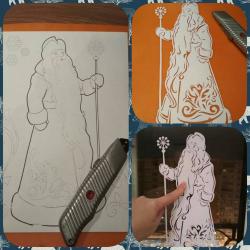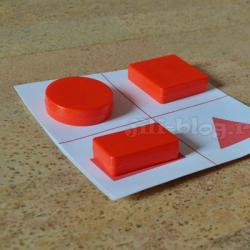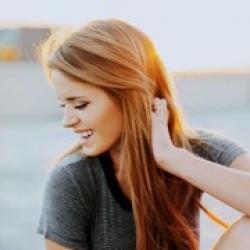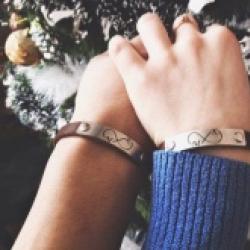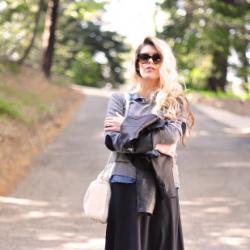Monochrome in clothes. Features of creating a monochrome image - total look. Monochrome: the meaning of the word in the explanatory dictionary
One of the timeless fashion trends is the monochrome look. Monochrome in clothing is a combination of things of the same color scheme in an image, and it can be all things of the same shade of color, or things of different shades of color. Images created using this technique look calm and elegant. Following these simple rules will help you learn how to put together such outfits and look stylish.
If you are planning to create a monochrome look in one color, then use things from different textures. We combine smooth with textured, matte with shiny, dense with transparent, knitwear with fur, and so on.




If monochrome is made up of things with same texture, you should not try to select them in the same color. Color nuances will make the outfit more interesting. It is important that the difference in shades is sufficiently noticeable. Otherwise, the set will look dubious and sloppy. In the set, the most saturated shade plays the role of an accent, and the rest serve as its background.





If a monochrome image is created from same material and color, it is advisable not to “cover the body” too much. This will eliminate the feeling of a large color spot. A monotonous outfit can be enlivened by adding a small spot that contrasts with the main color in the form of a belt, shoes, or bag.




Since nothing stands out in color in a monochrome look, the silhouette of the outfit should be perfectly clear, have a classic cut, and a minimum of jewelry should be used. This is especially important for things of dark colors.


When creating a monochrome look, your outfit has one continuous line from head to toe, which visually lengthens your silhouette, making you look slimmer and taller.
This trend can be clearly seen on the catwalks, fashion weeks, and in the images of stars. Monochrome clothing is at the peak of popularity this season as well. Let's not forget about. How to independently and competently create a monochrome image? What are the options?
1. Create a monochrome look from different shades of the same color
In this version, the look is assembled from shades that are similar in color. For example, we take as a basis the color red that is fashionable this season. We dilute it with delicious berry variations, for example, raspberry or lingonberry (or scorching scarlet). Ready!
Kris Jenner.
2. Create a monochrome look in neutral colors
A wonderful idea for sophisticated, calm outfits. Give preference to your favorite neutral color and select all items in this range. Dress in cream, any shade of gray (instead of black), beige, all white or black. Choose any option.
 Gigi Hadid
Gigi Hadid
3. Create a monochromatic look
A characteristic feature of this look is that clothes and accessories must be in the same color scheme.


4. Add an accessory of a different color
She demonstrated such a luxurious look at fashion week. The girl diluted her monochrome outfit with an excellent color accessory. In principle, this can be not only shoes, but also a bag, an accent belt or a bright headdress. This technique (with an accessory) is the most popular; it works quite beautifully with different colors.
 Olivia Palermo
Olivia Palermo 
 Outfits Margot Robbie
Outfits Margot Robbie 5. Mix textures of the same color scheme
In such sets you need to play with the difference in textures. Don't be afraid, don't hesitate, but mix and match. When different textures coexist in one look, it looks especially rich and very stylish. You can create something exclusive or an excellent work kit. Experiment!
 Kendall Jenner
Kendall Jenner Monochrome is an important trend in modern fashion, which in general is increasingly flirting with simplicity, minimalism and the “new modesty”. And if previously monochrome was more often understood as black, white and their combination, now pastel harmonies are increasingly appearing in lookbooks and fashion shows.
In general, monochrome looks are good because it’s easier to work with one color (or its shades) than with a set of colors, and even if we’re just talking about jeans and a top, it’s much easier to create a stylish look using similar colors than racking your brains over contrasting combinations . Of course, one does not cancel out the other (especially if you get along with), but as a way to look elegant and simple, monochrome is a great strategy.
The main rule that you need to keep in mind when composing a monochrome image is the same materialist dialectic: the principle of unity and struggle of opposites. We build on the unity of color and play with opposing shapes and textures: we combine voluminous with tight-fitting, smooth with rough, rough with thin, hard with soft, matte with shiny, short with long.
The safest option is simple dark colors: black or rich dark blue (navy), dark dark gray (off black): since they are dark, the difference in shades is not so striking and in general the combination of even different blacks looks harmonious. Well, the practical point is also important: you will always find basic colors in any department of any store. You can dilute this look with any metallic color item or any other color accent (just one!).








A little more complicated - white and milky shades. In them, the degree of whiteness/cleanliness may vary more noticeably and you need to be more careful to ensure that all elements of the image are slightly different from each other (otherwise you will end up with a doctor’s or waiter’s costume).
Lenny Niemeyer São Paolo Spring 2017 Fashion Show

Leandra Medine / Article from Man Repeller

stylememos.co.uk




A slightly more complex method is to combine shades of the same color with different saturations. Here you actually need to have a pretty good eye to choose colors from one “column”, otherwise the final combination may look sloppy (it may not look if you are a natural colorist or are ready to spend a very long time applying different things to each other, but we’re talking about how to make it easier).

It is super important that the different shades are the same in terms of dustiness. If you explain this in terms of paints, it will be something like this: you take blue watercolor and dilute it with water, it turns out light blue, then you dilute it again, it turns out blue, then again, it turns out light blue, and so on until white. But the “purity” of the color will remain the same if you did not dip the brush into another paint.

Bright with faded - it’s immediately a feeling of “picking and picking, but not picking.” A more “dusty” color against a clean background seems dirty and washed out. And it will be something like in this set - it looks like blue and blue, but together it’s bad

The same applies to shades of different warmth and coldness.

In general, going through all this is quite boring, and most importantly, it’s not difficult to make a mistake, even if everything is fine with your eyes according to the results of the design test with squares. Because the lighting in different stores is different, and you can only remember what shade of sweater you have on the shelf at home if you are a damn genius. Therefore, in order not to complicate your life, there is a simple life hack: the difference in purity and temperature will be clearly visible if you use the entire color range, from the lightest to the darkest, but if you take only the light part of the sector (starting with white) or, conversely, the darkest , then combining will be much easier.
In general, look at the examples: “safe” combinations of things of the same color of different saturation:

stealthelook.com.br


Every autumn, in anticipation of the winter blues, I dress in black and gray, but by the end of February I want to immediately burn it all and create a completely new wardrobe in bright and cheerful colors. I’m probably not alone in my aspirations, otherwise how else can I explain that the autumn-winter collections of most brands are made in darker and deeper colors, while the spring-summer offer us different variations of light and bright. Along with the desire to buy all this yellow-pink-blue-orange, concerns usually come: what to wear it with? These concerns often lead us to avoid colors we know nothing about and stick to a few traditional patterns we learned a long time ago.

Choose the appropriate color. For example, rich yellow. We click on the combination diagram (or better yet, on everything in turn) and we get 6 ready-made palettes.






We take screenshots on our phone and go to the store with them.
What else?
There are several websites that create photo-based color palettes with vibrant color schemes. It’s worth visiting them to get inspired, or to choose specific combinations for the desired color. For example:
in color balance (this is the site of designer, colorist and photographer Alex Romanuke, who creates palettes by hand)







You can go the third way: take a photo of the combination you like and break it down into colors by uploading the picture to sites like pictaculous.com or color.adobe.com (this Adobe application compiles palettes according to schemes, like colorscheme, and lays out the uploaded photo into a scheme).
Actually, color combinations are not exhausted in 6 schemes, because we take them from nature, which is beautiful and diverse. To work well with color, you should focus on natural combinations, the works of great artists, designers, architects and photographers. Of course, this does not mean that we will be able to repeat the same complex color combination right away or come up with something of our own, just as ingenious, but the same rule works here as with “innate” literacy and style in a language: to write well, you need read a lot of good literature.











Good work with color and more brightness in your life!

